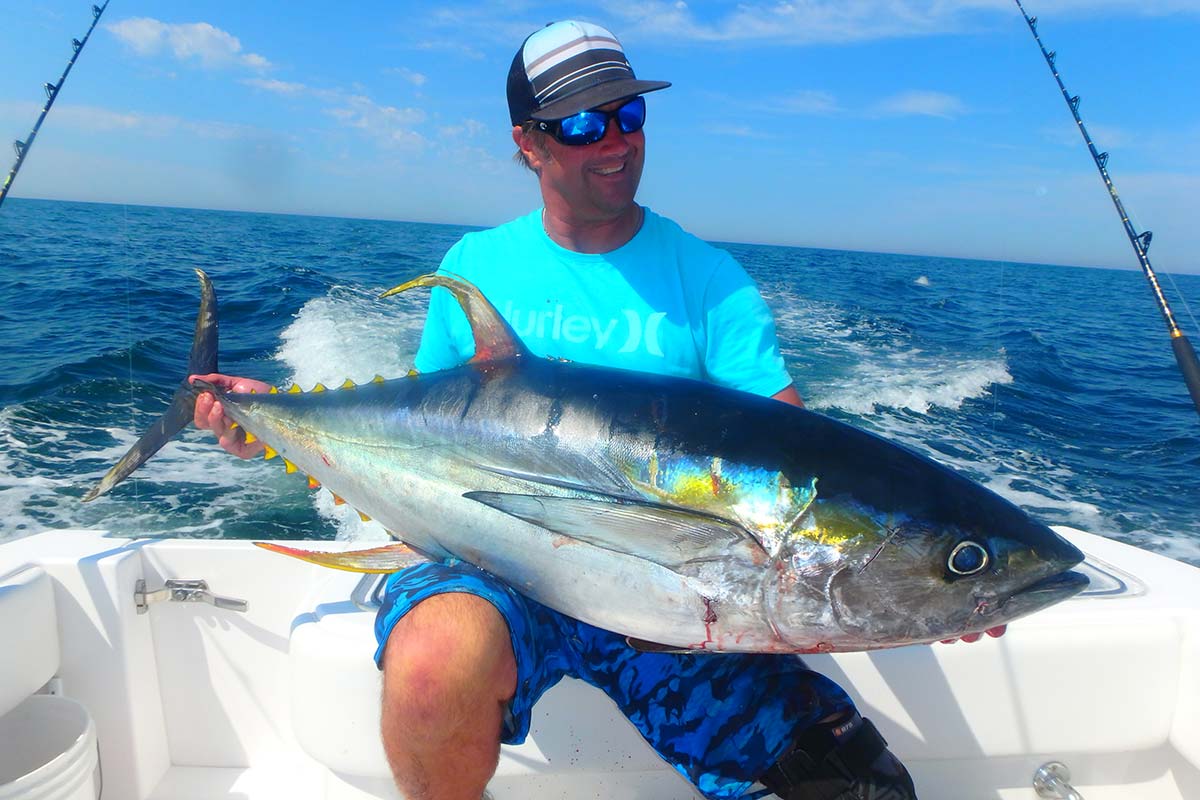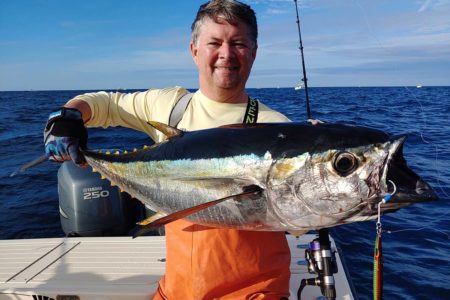
Sometimes it pays to get away from the crowds.
Everybody complains about the fleet, yet it’s the first thing we see after a 3-hour ride to the tuna grounds. Suffice it to say; you’re probably going to want to fish it immediately!
It’s easy to fall into the trap; it’s the low-hanging fruit. We’ve all been there, including me. Of course, I’m going to want to drop where everyone else is fishing first. But oh grasshopper, there is a reward in patience and solitude.
Sure, the fleet may be into some fish, and maybe the right call is to get the lines in and see if anything is truly blowing up to start. But don’t let the addiction burn you. Savvy offshore anglers know to distance themselves from the craziness, not just for peace of mind but for amping up your catch rate, and here’s why.
Fear Factor
Nobody likes to eat while they’re being watched or when a loud heavy metal band is blaring in their ears. Apply that same thinking to tuna. In a tight fleet, all the engines, commotion, and boats circling about will spook fish, push them down, and cause lockjaw among the tuna schools. The first boats to start a fleet may be spaced out far enough not to spook the fish, but when hundreds of boats come on the scene, you’ll notice marks on the fishfinder but they simply won’t bite, and that’s due to the noise in the area. The solitude away from a fleet will allow tuna to feed more naturally and comfortably, making them more receptive to poppers, plugs and even on the fly.
Stray Bait
Baitfish that get separated from the school are easy prey for gamefish. Feeding tuna will gladly get away from the big bait pods to section and separate out bait schools so they can have them for their own picking. Rarely will you see bait pods coming to the surface smack dab in the middle of the fleet. Most times, tuna will push bait up to the surface when there is nothing on the surface to keep the bait down, i.e., boats. It’s much easier to convince a tuna to strike at a lure or bait if it can feed pin-pointedly on a small bait pod to pick out the weak and easy meals. Roaming nomad schools of bait exist outside the fleet, and you’ll find plenty of action to yourself on the pods.
Pick Your Spot
The fleet is not all that bad, it can be the indicator of where tuna may be in a given area, but the ocean is large and vast. The outskirts of the area are usually as productive or even more so than the fleet itself, with way less competition. Try a mile away from the fleet to start as tuna schools move fast and furious and break off from the feeding frenzy. If no activity happens on the outskirts, then a 5- to 10-mile move may be in your favor to explore the general grounds, following fathom and contour lines that are similar to where the tuna are feeding in the fleet. Chances are you’ll happen on bait pods, whales and roaming tuna schools on your own.
No Sinkers Thrown
Yeah, we’ve all heard the stories and threats. Lobbing bank sinkers into another person’s boat because they cut your trolling spread or ran over your line when fighting a fish. Do you really want to engage in that street combat out in the endless ocean, a place of peace? I’d rather catch a few fish and forgo a light ’em-up day to fish in peace rather than compete and cause a ruckus in the maelstrom of a tight fleet. We’ve all got enough stress at home; leave it at the dock.
Create Your Own Intel
Possibly one of the most rewarding experiences when tuna fishing is picking your own spot and actually catching fish there from educated guesses. When that happens, don’t tell a soul. Head right back out to the same spot or adjust accordingly to overnight currents, tides and chlorophyll movement to point yourself in the right area for the next day’s trip. You can create your own intel, but the hard part is not telling anyone you know about it. The general rule of thumb is if you can keep your mouth shut, nobody will be in your spot the next day. Tell one super-trusted friend and swear them to secrecy, and he will tell one friend only. Tell two trusted friends and a dozen people will know. Post it on social media and it’s nobody’s fault but your own when the world comes to blow up your spot.
The point is, if you put in the time and hours and pain to find your fish, keep it quiet for a few days and enjoy the fruits of your labor. I know it’s tough to do, but sometimes, a zippered mouth is the finest asset you can possibly have to increase your catch rate exponentially.




